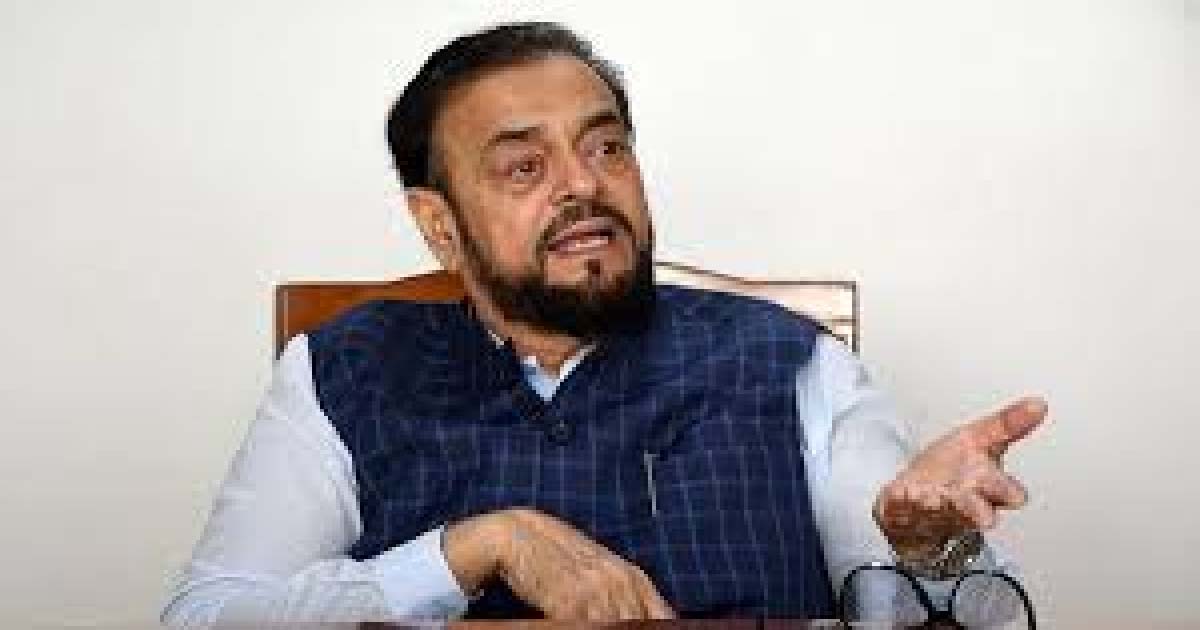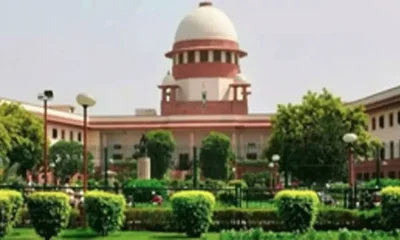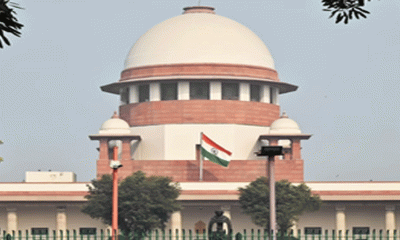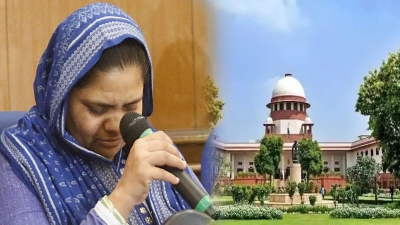Politics
Places of Worship Act put to test as Gyanvapi mosque case goes to Supreme Court

The three-page legislation — The Places of Worship Act, 1991 — is at the centre of the row over videographic survey carried out at the Gyanvapi mosque in Varanasi, where a Shivling was purportedly discovered.
The law has been invoked by the Committee of Management, Anjuman Intezamia Masajid Varanasi, which manages the Gyanvapi mosque, before the Supreme Court, saying mischievous attempts were being made to change the character of the mosque, which existed for 500 years.
In the Ayodhya judgment, the Supreme Court had said that the Act is intrinsically related to the obligations of a secular state and it reflects the commitment of India to equality of all religions.
However, in the Gyanvapi mosque matter, the Act will be put to legal scrutiny and face a test, in view of the ethos of secularism.
A bench comprising Justices D.Y. Chandrachud, Surya Kant, and P.S. Narasimha observed that the survey of a structure to ascertain its religious nature is not barred under the Act.
The committee moved the top court under Order 7, Rule 11 of the Civil Procedure Code against the maintainability of the suit, filed by five Hindu women seeking enforcement of their right to worship Goddess Shringar Gauri and other deities inside the mosque.
The masjid committee has also questioned the appointment of a commissioner for the video survey of the mosque, as it was barred under the Places of Worship (Special Provisions) Act, 1991, and pointed at the fallout of entertaining a suit in gross violation of the provisions of the 1991 Act.
The counsel representing the masjid committee argued in the apex court that similar mischief is being attempted in connection with four-five other mosques and objected to the trial court order to protect an area which had been used for the last 500 years by Muslims as ‘wuzu khana’ (ablution pond).
The Places of Worship Act, 1991 had its own share of controversies. The then Union Home Minister, S.B. Chavan, while moving the Bill in the Lok Sabha had said that it is a measure to provide and develop our glorious traditions of love, peace and harmony.
However, the BJP, then main Opposition party, had opposed the Bill tooth and nail, and termed it as another attempt by the Congress government to appease the minorities.
The Central government notified the Act to forestall fresh claims by any community about the previous designation of any religious place of worship and also subsequent attempts to regain land, on which they stood.
The Places of Worship Act, 1991 begins by saying, “An Act to prohibit conversion of any place of worship and to provide for the maintenance of the religious character of any place of worship as it existed on the 15th day of August, 1947, and for matters connected therewith or incidental thereto.”
Section 4 of the Act says, “It is hereby declared that the religious character of a place of worship existing on the 15th day of August, 1947 shall continue to be the same as it existed on that day.”
The Section 4(2) of the Act says any suit, appeal or other proceeding with respect to the conversion of the religious character of any place of worship, existing on August 15, 1947, is pending before any court, tribunal or other authority, the same should abate, and no fresh suit or legal proceedings would be instituted.
And, the proviso to this section clarifies that only those litigations are allowed, where conversion has taken place in the religious character after August 15, 1947. The offence under the Act is punishable with imprisonment for a term which may extend to three years and also a monetary penalty.
According to the Act, if a person attempts to convert any place of worship, or is part of a conspiracy, she/he can face a jail term.
The Act has put the Ram Janmabhoomi-Babri Masjid dispute outside its domain of operation. However, the Supreme Court in its Ayodhya judgment cited its importance. In November 2019, the Supreme Court ruled in favour of the Hindu side paving the way for the construction of Ram temple in Ayodhya.
The apex court had then said The Places of Worship Act is intrinsically related to the obligations of a secular state and it reflects the commitment of India to the equality of all religions.
“Above all, The Places of Worship Act is an affirmation of the solemn duty which was cast upon the state to preserve and protect the equality of all faiths as an essential constitutional value, a norm which has the status of being a basic feature of the Constitution. There is a purpose underlying the enactment of The Places of Worship Act. The law speaks to our history and to the future of the nation,” the top court had said.
The five-judge bench had said: “Historical wrongs cannot be remedied by the people taking the law in their own hands. In preserving the character of places of public worship, the Parliament has mandated in no uncertain terms that history and its wrongs shall not be used as instruments to oppress the present and the future.”
The apex court had said The Places of Worship Act imposes a non-derogable obligation towards enforcing “our commitment to secularism under the Indian Constitution and the law is hence a legislative instrument designed to protect the secular features of the Indian polity, which is one of the basic features of the Constitution”.
“Non-retrogression is a foundational feature of the fundamental constitutional principles of which secularism is a core component. The Places of Worship Act is thus a legislative intervention which preserves non-retrogression as an essential feature of our secular values,” it had said.
On May 20, 2022, the top court noted that ascertaining the religious character of a place of worship through a procedure known to the law, will not fall foul of The Places of Worship Act, 1991. The top court has shifted the trial of the suit by the Hindu parties from civil judge, senior division, to the district judge.
The top court said its May 17 interim order — protecting the ‘Shivling’, purportedly discovered during the survey, and free access to Muslims for ‘namaz’ — will remain operational for eight weeks, after the district judge’s decision in the matter, so as to allow the aggrieved parties to appeal against the decision.
The Supreme Court has scheduled the Gyanvapi case for hearing in July.
National News
J&K to receive Rs 5.5 billion investment in tourism sector: Omar Abdullah

Srinagar, Dec 13 (IANS) Chief Minister Omar Abdullah said on Saturday that J&K is set to receive Rs 5.5 billion investment in the tourism sector under an externally funded project.
Omar Abdullah hoped that the investment and collective effort would help J&K establish itself again as India’s leading adventure tourism destination.
Earlier in the day, the Chief Minister inaugurated Asia’s longest ski drag lift at Kongdori, Gulmarg. This landmark addition will significantly enhance skiing infrastructure and further strengthen Gulmarg’s standing on the international winter sports map.
The Chief Minister also inaugurated the rotating conference hall at Affarwat, Gulmarg. He was accompanied by Advisor Nasir Sogandi, MLA Gulmarg Farooq Shah and MLA Zadibal Tanvir Sadiq.
Later Addressing a gathering of adventure tour operations, who are here to attend 17th annual convention of the Adventure Tour Operators Association of India (ATOAI) being held from December 17th to December 20th, the Chief Minister said Jammu and Kashmir has immense natural potential and, if properly blended with professional experience and coordinated work, there would be no difficulty in restoring its past position in adventure tourism.
Omar said he had made the point earlier as well that the success of tourism should not be measured by bringing tourists to Kashmir once, but real success would be achieved only when tourists feel motivated to return repeatedly, year after year.
He said the approach of the government and the tourism sector should always be centred on long-term engagement with visitors.
“Our attempt should be that tourists say they will not go anywhere else and will come only to Kashmir to celebrate their vacations. Such a goal could be achieved only if all stakeholders worked together,” he said.
The Chief Minister added that the tourism department and all related agencies must act in coordination to strengthen the sector and improve the overall tourist experience.
“It has been extremely difficult for Jammu and Kashmir, with setbacks and troubling incidents emerging from different places almost every month. At times, it felt as if the region was being repeatedly hit from one side or another,” he added.
Omar said that even the hope of some relief during winter did not fully materialize as the season remained largely dry, which further impacted tourism and those dependent on it for their livelihoods. He asked people to pray for snowfall, but not in such a measure that it becomes unbearable.
Maharashtra
Maharashtra: Abu Asim Azmi presents bill in the House against religious hatred and blasphemy, application of MCOCA and UAPA also included in the draft bill

Mumbai: Nagpur Samajwadi Party leader and MLA Abu Asim Azmi presented a private bill in the Maharashtra Legislative Assembly against those who spread blasphemy and religious hatred. The bill demands action against hate elements and calls for action under MCOCA and UAPA against those who spread religious hatred, in addition to ten years of imprisonment and a bail of Rs 2 lakh so that sectarians do not get bail and such cases of spreading religious hatred are banned. He told the House that there has been an increase in cases of blasphemy in the country and in such a situation, tension arises in the country. Action should be taken against such elements to maintain law and order. This will be possible only when action is taken against such sectarians who promote a hate agenda under the guise of freedom of expression. He said that the Supreme Court had also issued an order for strict action against hate elements and miscreants and has banned inflammatory and hate speech. In such a situation, Maharashtra The bill has been formally introduced in the House to take action against those who spread religious hatred and incite hatred against important people. The draft bill proposes to register a case against communalists under the section of the MCOCA UAPA, which carries a maximum sentence of ten years, so that such elements cannot be granted bail.
Maharashtra
Mumbai fuel theft gang busted, 13 accused arreste, The gang of thieves had attempted to steal fuel in November

Mumbai: Police claims to have busted a petrol theft gang. The accused were arrested for attempting to steal petrol from BPCL company on November 14 at around 3:30 am under the limits of RCF police station in Mumbai. A complaint was registered for attempting to steal fuel from the underground 18-inch Mumbai Manmade Multi-Product pipeline on Mumbai Gadkari Road. Vinod Devchand Pandit was arrested from Chembur on November 17 on the basis of technical investigation and information from an informant. His investigation revealed that the mastermind of this racket, Riaz Ahmed Ayub (59), Salim Mohammad Ali, Vinod Devchand Pandit had hatched a plan to steal fuel. 13 accused including Gopal Narayan, Mohammad Irfan, Vinay Shashikant, Ahmed Khan Juman Khan, Nishan Jagdish, Mustafa Manzoor, Nasir Shaukat, Imtiaz Asif have been arrested. All these accused have been arrested from various areas. Their arrests were made from Mumbai, Navi Mumbai and surrounding areas. This operation was carried out by Additional Commissioner Mahesh Patil and DCP Sameer Sheikh on the instructions of Mumbai Police Commissioner Deven Bharti.
-

 Crime3 years ago
Crime3 years agoClass 10 student jumps to death in Jaipur
-

 Maharashtra1 year ago
Maharashtra1 year agoMumbai Local Train Update: Central Railway’s New Timetable Comes Into Effect; Check Full List Of Revised Timings & Stations
-

 Maharashtra1 year ago
Maharashtra1 year agoMumbai To Go Toll-Free Tonight! Maharashtra Govt Announces Complete Toll Waiver For Light Motor Vehicles At All 5 Entry Points Of City
-

 Maharashtra1 year ago
Maharashtra1 year agoFalse photo of Imtiaz Jaleel’s rally, exposing the fooling conspiracy
-

 National News1 year ago
National News1 year agoMinistry of Railways rolls out Special Drive 4.0 with focus on digitisation, cleanliness, inclusiveness and grievance redressal
-

 Maharashtra1 year ago
Maharashtra1 year agoMaharashtra Elections 2024: Mumbai Metro & BEST Services Extended Till Midnight On Voting Day
-

 National News1 year ago
National News1 year agoJ&K: 4 Jawans Killed, 28 Injured After Bus Carrying BSF Personnel For Poll Duty Falls Into Gorge In Budgam; Terrifying Visuals Surface
-

 Crime1 year ago
Crime1 year agoBaba Siddique Murder: Mumbai Police Unable To Get Lawrence Bishnoi Custody Due To Home Ministry Order, Says Report




















